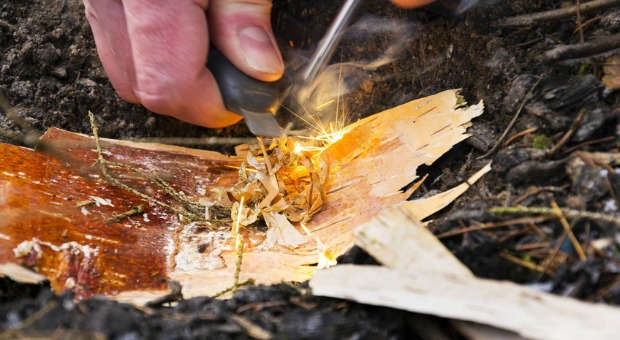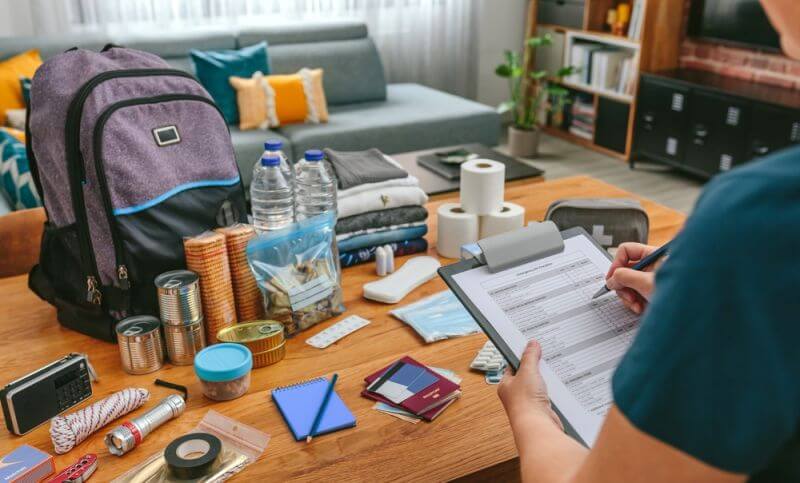To begin with, I’d take it as an axiom that any respectable prepper should know how to start a fire in an emergency. Also, I am a firm believer in the theory that any bug out bag or survival kit should pack a fire starter, together with a couple of Bic lighters, just in case.
If you’re wondering why, well, you should contemplate the fact that fire is maybe the most important invention in the history of mankind.
For starters, fire keeps you warm and that’s quite important during the winter season, especially when confronted with a survival situation, i.e. you get lost out in the big bad wood or whatever.
I am aware of the fact that we live in a day and age when people don’t go out much, especially in the woods/in the wilderness. Getting lost is a pretty rare occurrence as we’re surrounded by high-tech GPS capable gadgets, Google Maps at our fingertips, mobile internet, offline maps and whatnot.
However, nasty things can happen at any given moment. The likes of earthquakes, hurricanes, terrorist attacks or good-old power outages may render your central heating system useless in no time.
There are also still folks out there, in flyover country, so to speak, who still go out hiking and hunting (in my time it was called having fun), even in the winter, so you may face a situation where having a fire starting kit will save your life.
So, ranting aside, besides keeping you warm and preventing frostbite from incapacitating you in an emergency, fire will allow you to cook your food, purify water for medical treatment or drinking, keep wild animals away, and signal your presence during the night or during the day via smoke signals.
Survival isn’t all that fire is about though; it’s also needed for complex things that made civilization possible, like metallurgy or pottery.
Yes indeed folks, fire is pretty important in almost all aspects of our modern life, yet we seem to take it for granted, as we got lazy due to our high-tech dominated and lavish lifestyle.
Getting back to our story, let’s talk about a few ideas with regard to DIY-ing emergency fire starters.
To begin with, I bet you’ve already watched a dozen movies where Crocodile Dundee or that weird dude which has the improbable name of Bear Grylls is rubbing 2 sticks together and somehow a fire magically appears. Believe me folks, that’s next to impossible if you’re a regular guy who never tried that before (like 200 times).
Here, the fire starter kit comes into play because, after all, we’re living in the 21st century and we’re supposedly smarter than your average troglodyte in the Amazonian jungle (I am not sure all of those guys discovered fire yet).
An emergency fire starter kit is aimed at making your survival story more pleasant and interesting to tell to your friends, and also more probable, as in “Staying Alive”, if you know that Bee Gees song.
What I am trying to tell you is that even if lighters or matches, are the easiest way to start a fire, having an emergency survival kit is pretty cool and it will make you stand out in the prepper crowd.
Joking aside, the main purpose of a fire starter kit is to help you with making a fire in adverse weather conditions (read rain, wind, snow or any combination of 2), when a simple lighter will not suffice.
1. Mini Fire Starter Kit
The first DIY project is the Micro Fire Starter Kit and it’s my personal favorite because it involves a Bic lighter, obviously.
The genius of this DIY fire starter kit is its simplicity. All you need is an old empty Bic lighter which is cut in half with a saw/knife or whatever. This creates a very small fire starter.
The striker still works obviously, and you’ll also use the storage chamber underneath (where the lighter fluid used to be) for your fishing hook.
You’ll also use cotton and the phosphorus paper, all of which are the must-have ingredients for an old school fire starter, sealed and waterproofed with hot glue for using in survival situations. I know what you’re thinking: you’d prefer a brand new/working Bic lighter instead of that DIY fire starter kit, but life is not always easy folks.
Video first seen on American Hacker.
2. Micro Emergency Fire Starter Kit
Here’s another idea for DIY-ing an emergency fire starting kit using another Bic lighter for creating an ultra-light and uber-tiny keychain survival tool.
This project involves some tinkering with the lighter, but you’ll end up with a very small emergency fire kit which uses the same principle, i.e. the working striker of a Bic lighter combined with cotton balls mixed with petroleum jelly as combustibles, that are stored inside the cut-down lighter’s innards.
Video first seen on MeZillch.
3. Pocket Size Fire Starter Kit
For another idea, take a look at this pocket-sized fire starter kit which is made from an old pain reliever tube and nothing much else. By nothing much else I mean old wax, a Ferro rod and a striker. But just watch the video and you’ll discover a very clever way for making a fire starter from scratch, and most importantly, one that really works well (I tried it myself).
Video first seen on supergokue1.
4. Self Igniting Fire Starters
Here’s a (clumsy) compilation of some of the best DIY self-igniting fire starters and combinations – a kit of sorts – which contains cool stuff like:
- a self-igniting pine pitch fire stick fire starter
- self-igniting dust fire starters
- pine pitch fireball fire starters
- pine pitch fire bomb fire starters
- fire crackle fire starters, fatwood fire stick fire starters
This also includes char rope, char cloth, and a fire light candle. The idea is that you can buy all these gizmos from eBay and see how they’re made, then try to reverse engineer them if you think they’re worth the stretch.
Video first seen on The Tera Farley Channel.
5. Chemical Based Fire Starters
Now with the old-school fire starter kits taken care of, let’s see how a chemist would make a fire in the absence of lighters, matches, Ferro rods, sticks and stones, etc.
Truth be told, this is something resembling a chemistry class, as the video tutorial will show you some pretty cool chemical reactions – four oxidation processes respectively – which will all result into an open flame, provided you have the materials at the ready.
Basically, you’ll learn how to make a fire without matches if you get lost in your chemistry lab or something along these lines. The idea is that you’ll require sulfuric acid, potassium permanganate (these are hard to get over the counter), potassium chlorate, zinc powder, glycerol, acetone, ammonium nitrate and several other chemicals. It’s never a bad idea to know how to make fires this way because you don’t know what situation you may find yourself in.
However, as far as chemistry experiments go, these ideas are among the best out there, being nothing short of spectacular. Just don’t let your kids see the video, okay?
Video first seen on Thoisoi2 – Chemical Experiments!.
6. How to Make Fire With a Lemon
I saved the best for last, as you can imagine. Now, sit down, take a deep breath and learn how to make a fire with a lemon.
Yes, folks, you can make a fire with a lemon if you’re from Sweden and you have a thick accent. Okay, and you have lemons, obviously.
This is not a joke, as the principle behind the lemon fire starter is pretty straightforward: the lemon is an acidic fruit, the juice inside is the electrolyte, and sticking a few copper/zinc pins (think electrodes) into the lemon will make for a primitive circuit which provides you with electricity when closed. You see where this is going, right?
The battery will be used for creating basically a short circuit via a thin wire, which will go incandescent in the process, meaning that you’ll be able to use it for lighting up dry tinder, thus making for a good fire starter by any measure.
Take a look at the video and see for yourself. It’s massive fun. As far as out-of-the-box workable ideas go, this one is the best in the world. I mean, if life gives you lemons, make a fire with them.
Video first seen on NorthSurvival.
And yes, it works, I’ve tried it.
If you have other ideas or comments, feel free to express them in the dedicated section below.
This article has been written by Chris Black for Survivopedia.









M Belcher | January 23, 2017
|
Keep lint from your dryer either dry or rolled in petroleum jelly handy in a waterproof package.
willowa | January 23, 2017
|
One of the best fire starters I’ ever used in, a book of paper matches, drip candle wax on it until full/soaked, close cover while wax is still soft. When needed, open cover and or, bend out a couple of matches and light. Really burns hot, and for a reasonable length of time, doesn’t take up much room.
willowa | January 23, 2017
|
Sorry, “One of the best fire starters I’ve ever used is,…”
Crystal Hayward | January 23, 2017
|
I’ve been saving my lint from the dryer to have to start fires with . It’s light weight and could keep in a zip plastic bag and that will keep it dry till you need it.
Joe | January 25, 2017
|
Wow, I had no clue you could make fire with a lemon! 😀 I learn something new every freakin’ day, thank you very much!
Joe
Joe | January 29, 2017
|
Also wanted to add that I liked the #1 as well,
PseudoGeek | February 1, 2017
|
This is supposed to be about survival techniques. So all you need to do to make a fire if you’re lost in the wilderness is to obtain a lemon, get some copper pins and some galvanized nails, some electrical wire, toilet paper, and steel wool. NO PROBLEM. I run across all the above constantly in the forest….
Pingback:3 Steps To Start A Fire When Everything Is Wet | Survivopedia | February 2, 2017
|
Pingback:Emergency Fire-starter: Start A Fire With Bare Hands | Survivopedia | February 9, 2017
|
Pingback:Grand Canyon Survival Story: Student Stayed Alive. Could You? | Survivopedia | March 27, 2017
|
Pingback:How To Make A 5 Gallon Bucket Survival Kit | Survivopedia | October 31, 2017
|